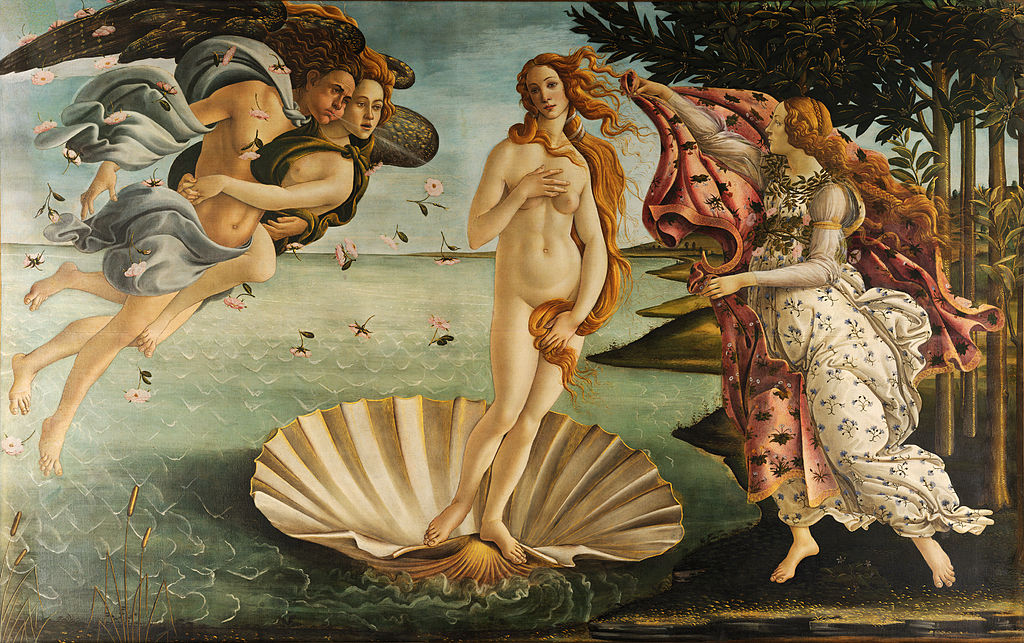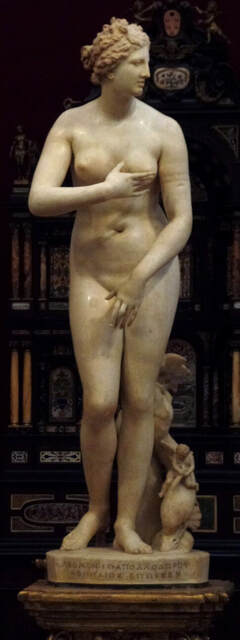|
Where? Room 10-14 of the Uffizi Museum
When? Between 1482 and 1485 Commissioned by? Lorenzo the Magnificent (1449-1492), ruler of the Florentine Republic and one of the most important driving forces of the Renaissance.
Symbolism: Violets, the flowers of love, are blowing in the wind on the left. The shell represents feminism. The dress of Ores and the robe she is holding for Venus are decorated with various spring flowers related to the birth theme, including red and white daisies, blue cornflowers, and yellow primroses.
Who is Venus? Venus is the Roman goddess of love, beauty, sex, fertility, prosperity, and desire. According to the myths, she was born from the foam of the sea. This happened when the Titan Cronus castrated Uranus, his father, whose genitals fertilized the sea and led to the birth of Venus. The goddess Venus is known in Greek mythology as Aphrodite. In Latin, Venus means ‘sexual desire’. Venus is the mother of Aeneas who survived the fall of Troy and fled to Italy. As such, Venus was considered the mother of the Romans and therefore a very popular goddess among the Romans. Perhaps because of this, Julius Caesar claimed to be an ancestor of Venus. Why Venus? Whereas Mary was the ideal woman to paint from a Christian point of view, Venus represents the moral dangers and shame of the human body. Christianity taught the people to be ashamed of the nude human body. Botticelli was trying to blend the Christian worldview and the arising humanist worldview. From that background, you can understand why Venus is still partly covering her nakedness with her hair (the Venus of Urbino painted in 1538 by Titian will show you a much more explicit depiction of Venus). This is a transition from religious art to Renaissance art. In some sense, Venus represents the opposite of Mary.
Who is Botticelli? Sandro Botticelli (1445-1510) was a painter that belonged to the Florentine school of painters. He was a student of Filippo Lippi. Botticelli was in love with Simonetta Vespucci (a cousin-in-law of the explorer Amerigo Vespucci), who was already married to Marco Vespucci. Simonetta was known as the greatest beauty of her time and died in 1476. As a result of that Botticelli never married. Throughout his life, he has been inspired by Simonetta, who has served, according to popular belief, as the inspiration for many of his paintings (including this painting). According to his wish, Botticelli was buried at the feet of Simonetta Vespucci. Other masterpieces by Botticelli include La Primavera in the Uffizi and Venus and Mars in the National Gallery.
Fun fact: Many people have noted the ‘cadaverous’ color of Venus, which is not considered very attractive. This was not some macabre fantasy of Botticelli, but merely a consequence of the deterioration of the pigment over time. And if you look carefully, the neck of Venus and her left arm are longer than you would expect. Botticelli incorporated these elongations on purpose as they were considered a form of beauty. Interested in a copy for yourself? Poster and canvas.
Written by Eelco Kappe
References:
2 Comments
TripImprover
8/20/2018 12:29:21 pm
That is right. They slowly started to introduce nudity in art again in this period and within a few decades the male and female nude were fairly widely accepted again.
Reply
Leave a Reply. |
Categories
All
|
- Home
- Blog
-
Museums
- Alte Pinakothek
- Art Institute of Chicago
- Baltimore Museum of Art
- Barber Institute of Fine Arts
- Bargello
- Barnes Foundation
- British Museum
- Church of Sant’Anastasia
- Cleveland Museum of Art
- Courtauld Institute of Art
- Detroit Institute of Arts
- Frans Hals Museum
- Galleria Borghese
- Gallerie dell'Accademia
- Getty Museum
- Guggenheim
- Hermitage Museum
- Kunsthistorisches Museum
- Kunstmuseum Basel
- Legion of Honor Museum
- Louvre
- Mauritshuis
- Metropolitan Museum of Art
- Musee d’Orsay
- Museum of Fine Arts in Boston
- Museum of Modern Art
- National Gallery in London
- National Gallery of Art
- National Museum in Poznań
- Norton Simon Museum
- Ny Carlsberg Glyptotek
- Palace of Versailles
- Palazzo Pitti
- Palazzo Vecchio
- Petit Palais
- Philadelphia Museum of Art
- Prado
- Pushkin Museum
- Ravenna Art Museum
- Rijksmuseum
- San Diego Museum of Art
- Santa Maria delle Grazie
- St. Peter's Basilica
- Städel Museum
- Statens Museum for Kunst
- Tate Britain
- Tate Modern
- Timken Museum of Art
- Uffizi
- Vatican Museums
- Wallace Collection
-
Artists
- Altdorfer
- Anguissola
- Berlin Painter
- Bosch
- Botticelli
- Boucher
- Bronzino
- Bruegel the Elder
- Brunelleschi
- Cabanel
- Caillebotte
- Canova
- Caravaggio
- Carpeaux
- Cezanne
- Cimabue
- David
- Degas
- Delacroix
- De Maria
- Donatello
- El Greco
- Fontana
- Fra Angelico
- Fragonard
- Gauguin
- Gentileschi
- Gericault
- Gonzalez-Torres
- Goya
- Hals
- Hogarth
- Hokusai
- Ingres
- Leonardo da Vinci
- Lippi, Filippo
- Longhi, Barbara
- Lorrain
- Makovsky
- Manet
- Massys
- Matisse
- Merian
- Michelangelo
- Mochi
- Modigliani
- Monet
- Panini
- Parmigianino
- Perugino
- Picasso
- Pisanello
- Raphael
- Rembrandt
- Renoir
- Reynolds
- Rivera
- Rodin
- Rubens
- Scultori
- Seurat
- Steen
- Tintoretto
- Titian
- Toulouse-Lautrec
- Turner
- Uccello
- Van der Weyden
- Van Dyck
- Van Eyck
- Van Gogh
- Van Hemessen
- Vasari
- Velazquez
- Vermeer
- Veronese
- Vigée Le Brun
-
Locations
- Books
- About Us



